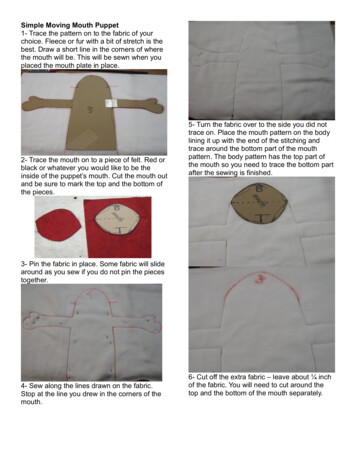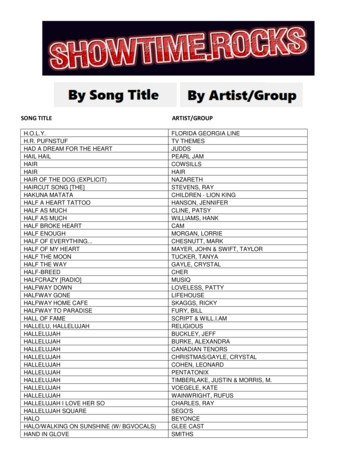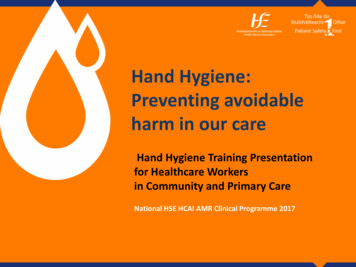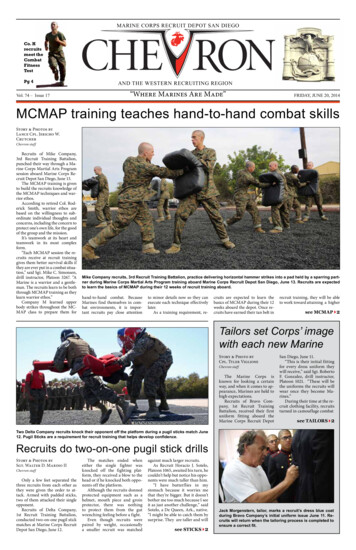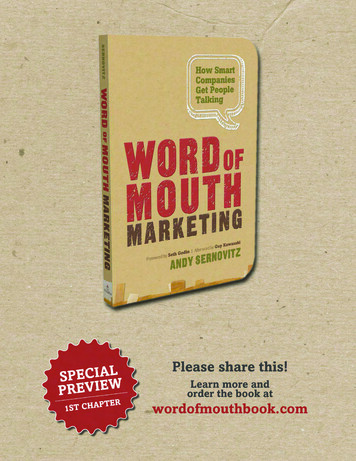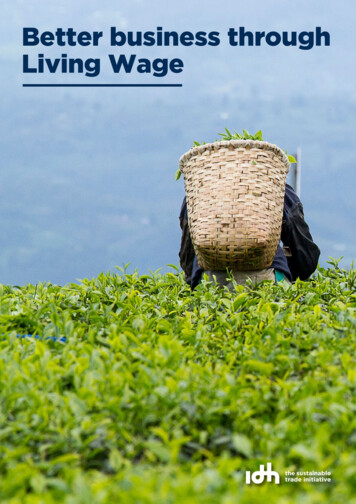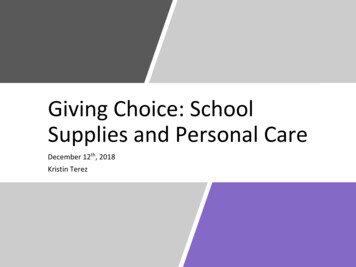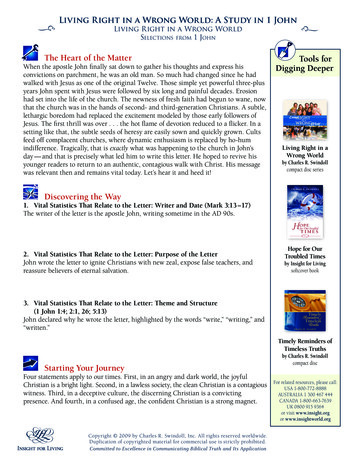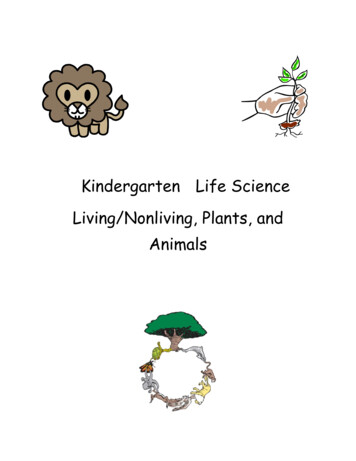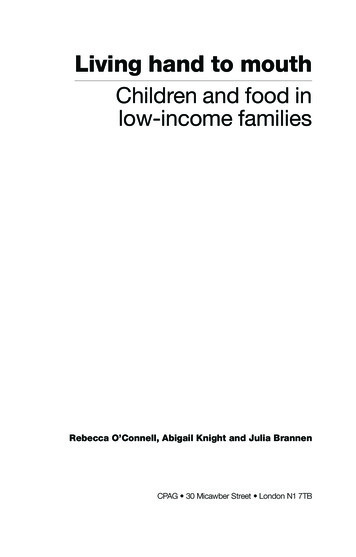
Transcription
Living hand to mouthChildren and food inlow-income familiesRebecca O’Connell, Abigail Knight and Julia BrannenCPAG 30 Micawber Street London N1 7TB
Child Poverty Action Group works on behalf of the more than one in fourchildren in the UK growing up in poverty. It doesn't have to be like this.We use our understanding of what causes poverty and the impact it hason children’s lives to campaign for policies that will prevent and solvepoverty – for good. We provide training, advice and information to makesure hard-up families get the financial support they need. We also carryout high profile legal work to establish and protect families’ rights.The views expressed are those of the authors and do not necessarilyrepresent the views of the Child Poverty Action Group.30 Micawber StreetLondon N1 7TBTel: 020 7837 7979staff@cpag.org.ukwww.cpag.org.uk Child Poverty Action Group 2019This book is sold subject to the condition that it shall not, by way of tradeor otherwise, be lent, resold, hired out or otherwise circulated without thepublisher’s prior consent in any form of binding or cover other than that inwhich it is published and without a similar condition including thiscondition being imposed on the subsequent purchaser.A CIP record for this book is available from the British LibraryISBN: 978 1 910715 47 5Child Poverty Action Group is a charity registered in England and Wales(registration number 294841) and in Scotland (registration numberSC039339), and is a company limited by guarantee, registered in England(registration number 1993854). VAT number: 690 808117Cover design by Colorido StudiosCover illustration by sketchpadstudio.comTypeset by Devious DesignsPrinted and bound in the UK by CPI Group (UK) Ltd
AcknowledgementsAcknowledgementsFirst and foremost, the authors would wish to thank the young peopleand their families who participated in the study. Thanks also to the UK andinternational research team, the research advisory group and the EuropeanResearch Council for funding the study. The research leading to theseresults has received funding from the European Research Council underthe European Union’s Seventh Framework Programme (FP7/2007-2013),ERC grant agreement number 337977. Funding for the book has beengratefully received from UCL Innovation and Enterprise’s KnowledgeExchange and Innovation Fund, supported by HEIF.We are very grateful for the enthusiasm and commitment of all those whohave contributed time and energy to this book. We are especially indebtedto Liz Dowler for her expert guidance and to Jonathan Bradshaw, AlanMarsh and Ruth Wright for their valued comments on the draft. Thanks aredue to Nicola Johnston for editing and managing the production, KathleenArmstrong for proofreading, and to Alison Garnham, Louisa McGeehan,Moussa Haddad, Lizzie Flew and other CPAG staff for their guidance.Special thanks to our colleagues at the Thomas Coram Research Unit fortheir support and to Alanna Ivin for her careful transcription of the interviews.For the children in the studyand in loving memory of Douglas Michael Wright(28 May 2013 –15 February 2018)
About the authorsAbout the authorsRebecca O’Connell is a reader in the sociology of food and families atthe Thomas Coram Research Unit, University College London (UCL)Institute of Education. She is co-author, with Julia Brannen, of Food,Families, and Work (2016) and principal investigator of the EuropeanResearch Council funded study, Families and Food in Hard Times.Abigail Knight is a lecturer in sociology at the Thomas Coram ResearchUnit, UCL Institute of Education. As well as teaching, she is a qualitativeresearcher with children and families and has researched and writtenwidely on the lives of young people in care, children with disabilities andfamilies living in poverty.Julia Brannen is professor of the sociology of the family at the ThomasCoram Research Unit, UCL Institute of Education and fellow of theAcademy of Social Science. She has an international reputation forresearch on methodology, the lives of children and young people infamilies, work-family life and intergenerational relationships. Recent booksinclude Fathers and Sons (2015) and Practising Social Research (forthcoming Policy Press).
ContentsForewordLouise Tickle, Education and social affairs journalist andOrwell Fellowvii1Introduction12Food poverty in Britain83Understanding food poverty194The study: Families and Food in Hard Times295Going without and getting by376Children’s experiences of school meals637Children’s social lives828What children say about poverty1079Summing up and recommendations124Appendix 1 Methodology and sample133Appendix 2 Calculating equivalised income quintiles 135
VI
ForewordForewordLouise TickleEducation and social affairs journalist andOrwell FellowEvery parent wants to feed their child. The drive to provide food for yourbaby is an overwhelming human instinct: hearing a toddler wailing ‘I’mhungry!’ is exquisitely painful to any mother or father who hears the cry.But what if there’s no milk, no bread, no baked beans, no cheese,no fish fingers, no peanut butter, no tuna, no fresh veg, no tomato sauce,no apples, no bananas, absolutely nothing in the cupboard – becausethere’s no money to make a trip to the shop?This book details, often in their own words, the lives of childrenwhose parents can’t afford to put regular meals on the table. There are fartoo many of them: over four million children in one of the richest countriesin the world are growing up in poverty, their access to adequate nutritioncompromised.As an education reporter, in recent years it has become ever moreapparent that teachers are worried about hungry pupils who can’t concentrate: their education suffers. Children in this book talk about theirshame at being on free school dinners, which affects relationships in theirfriendship groups, and can also lead to bullying. One mother in the booktalks about not eating for four days: it’s heartbreaking to then hear themounting anxiety children describe for a parent who is choosing to skipmeals in order that they may eat. The guilt at what their parents are enduring is a burden no young person should have to bear.While children arrive at school without breakfast, and later do theirhomework fuelled by nothing but a piece of toast, commentators are busytalking about various manifestations of poverty – housing poverty, periodpoverty, transport poverty, fuel poverty – but in the end, these are just different ways of saying the same thing: families are now struggling to givetheir children a decent start because there is not enough money to affordthe basics.Food banks are not the answer. Those who work in them acknowledge they are barely a sticking plaster. From the perspective of an alienvii
viiiLiving hand to moutharriving from outer space – or even a visitor from a country with a functional social contract – these warehouses of tinned and dried foodstuffsmust appear similar in their operation to the way ravenous people in conflict-riven areas are kept from tipping into starvation by distributions ofhumanitarian aid.That addressing ‘holiday hunger’ is also now a regular aspect ofmany charities’ work is also a burning indictment of a society unable toensure families have sufficient income to keep their children safe, secureand nourished.Food is so much more than just the building blocks that childrenneed to survive. Good food is fundamental to culture; it is a cornerstoneof building community; it is about being able to take part in social activitieswith your friends. These are not added extras; they are central to a goodlife. Food, ultimately, is about how well humans can thrive. And brutally, itcomes down to this: in the UK, in 2019, children’s lives are being blightedand their life chances curtailed because they are not getting what theyneed to eat.
1OneIntroductionFood is fundamental. It is essential to physical survival, a medium for theexpression of identity and central to a sense of belonging. Food thereforeprovides a revealing lens for understanding how poverty and low incomeaffect the lives of children and their families. Through the stories of childrenin 45 families, this book examines the reasons children go without decentfood and what they say about being excluded from eating in ways that arecustomary in Britain today.From Poverty Bites to Living Hand to MouthIn 1999, the then Prime Minister, Tony Blair, pledged to end child povertyin the UK within 20 years. Two years later, CPAG published Poverty Bites:food, health and poor families which explored the consequences for lowincome families struggling to afford sufficient food to maintain good healthin terms of their nutritional, health and social wellbeing.1 So, 20 years afterthe pledge to end child poverty, why are we still talking about food povertywithin families with children?During the 1997–2010 Labour administration, the task to end childpoverty started well. Welfare benefits, particularly for children, wereincreased and more help was given to raise earned income among families living in poverty and improve children’s services.2 Child poverty ratesfell significantly. Since then, however, the situation has seriously deteriorated. It is scarcely believable that the words of Maud Pember Reeves,written over a hundred years ago, need repeating today:3It is to the collective interest of a nation that its children should flourish.There should be no such thing as an underfed school child: an underfed childis a disgrace and a danger to the state.By 2012, the UK Poverty and Social Exclusion study suggested that wellover half a million children lived in families who could not afford to feedthem properly.4 Parents were unable to provide at least one of the following:
2Living hand to mouththree meals a day; daily fresh fruit and vegetables; or meat, fish or a vegetarian equivalent at least once a day. It found that if many parents werenot cutting back on their own food intake to protect their children, thenumber of children going without would be much higher.In the UK, one of the richest countries in the world, the outlook forchildren in low-income families is currently bleak. Child poverty targetshave been scrapped and poverty rates are rising. By 2021, five million children will be living in relative income poverty – that is, below 60 per cent ofaverage (median) income.Children, food and povertyAs Peter Townsend made clear, poverty is about more than low income.5In the UK, households with children are currently more likely to be living inpoverty than any other household type.6 Yet, we know very little abouthow children and young people living in different kinds of families negotiatefood and eating in conditions of disadvantage and inequality. It is in thecontext of what has been called ‘breadline Britain’7 that this book returnsto the fundamental issue of food in low-income families. It especially seeksto understand the problem from children’s perspectives.Food is fundamental to children’s lives and to their physical, emotional and mental health as growing individuals. The harmful consequences of poor diet intake and malnutrition, particularly for children, arewell established and have long-term implications. These include theincreasing incidence of coronary heart disease, type II diabetes and cancer.8 Indeed, the UK Faculty of Public Health argues that the recent evidence of increasing malnutrition constitutes a ‘public health emergency’.9Health and dietary inequalities in the UK are linked to inequalities inincome: 11–15-year-olds in less affluent families in England report lesshealthy eating, including lower consumption of fruit and vegetables, thanthose from more affluent families.10 In the UK, as elsewhere, poverty is alsoclosely connected to being overweight and obesity,11 a trend partlyexplained by the relative cheapness and wide availability of unhealthyfoods that are high in saturated fat and added sugars.12 Suboptimal dietsand food habits such as skipping meals are also associated with poorcognition and lower academic achievement as children’s ability to concentrate is damaged by insufficient food or food of low nutritious value.13
Introduction‘Sometimes you don’t have enough energy, you cannot cope in the classroom so you have to, like, try and rest a bit. You just put your head on the tableand you end up falling asleep in the classroom and you get in trouble for it.’(Emmanuel, age 14, does not have anything to eat during the school day)Food is also vital to children’s participation in society. It is an important lensfor understanding lived experiences of both material deprivation and socialexclusion. Eating with others plays a significant role in establishing andcementing social networks, with food mediating children’s attempts tomake friends and connect with others.14 Food is also integral to thereciprocal relationships of care in which children – and adults – areenmeshed.15 It is a medium for children’s expression of identity and controland, in a consumerised culture, choosing what food to buy and eat is ameans of enacting increasing autonomy as they grow older.16 Exclusionfrom the eating activities that form part of children’s and young people’s‘ordinary living patterns’17 may therefore be regarded as a dimension ofrelative poverty.18‘I don’t want to show them that, no, I don’t have enough money. I say tothem “no I don’t really want to come”.’ (Faith, age 15, on being invited to thecinema and for something to eat with her friends)Living Hand to Mouth is about children who are at significant risk of foodpoverty. It adopts a contextual approach that puts a spotlight on the material realities of children’s and young people’s lives in Britain today: what itmeans to live in low-income households that have constrained budgets,especially concerning access to food. It examines children’s accounts oftheir everyday experiences and the social, geographical and economicconditions in which they live.The studyThe book is based on a study of 51 children, from 45 families, in two areasof South East England that, given this is the richest region of Britain,increases the gap between rich and poor.19 It focuses on children’s experiences of food in different settings: at home, in school and out of school.The book also includes photographs of food taken by some of the children.These illustrate something of the diversity of the children’s backgrounds,3
4Living hand to mouththe kinds of food they selected and those that were available to them.Participants were given good-quality digital cameras to use and keep but,nonetheless, not all their photographs are of usual print quality. However,we felt strongly it was important to include them.The book sets children’s accounts in the context of what we alsolearned from interviews with their parents. It locates the children in theneighbourhoods where they meet their peers and in schools, in particulartheir experiences of school meals. It recounts how children felt about, andmanaged, the experience of poverty in general and of being seen to be‘poor’ as they compare themselves with peers in a highly consumeristsociety. Finally, it addresses who children hold responsible for ensuring, orfailing to ensure, that they have enough to eat.‘If a child dies the government is always serious about it. So, if the childdoesn’t die, they should still be serious about the child anyway.’ (Ayo, age12, West African, inner London)The chaptersChapter 2 sets out the political, economic and social policy contexts, particularly as they affect the money people have for everyday living. It examines the implications for living and food standards, including evidenceabout rising levels of food poverty in Britain considering the impact ofausterity for families. Chapter 3 describes the conceptual approachesOnions are ‘theonly thing thatlasts’, saysBryony’s mother.Her partner says:‘Sometimes whenwe’ve got moremoney there’d bepotatoes in there,there’d beparsnips, extrastuff.’
IntroductionFahad said this is‘just an averagedinner’: ‘pasta,sweetcorn, salt andpepper and somemince’.adopted in the book. It sets ways of thinking about food and poverty inhistorical context, before describing our approach to understanding children’s and families’ lives.Chapter 4 describes the study and the children’s families on whichthe book is based. In Chapter 5, we examine what food poverty is for thestudy families, in particular how far they go without proper food and howthey get by. We consider the variation among the sample in terms not onlyof the quantity of food available but also its quality. More importantly, giventhat the book is about children living in low-income families, we examinetheir experiences. This has involved taking a close look at their ownaccounts, and those of their parents, about what they eat. Key to understanding how children were affected is parental sacrifice: how far it waspossible for parents to protect children from going hungry or going withoutfood. We show that some parents successfully protected children whileothers could not and we examine the methods they used to get by andthe conditions under which this occurred.Chapter 6 addresses the food children eat in school. It begins bydescribing children’s experiences in the schools they attended, beforeexamining the place of school meals in the lives of these young people inlow-income families through cases of children who are entitled to freeschool meals and those who are not. A crucial dimension of this analysisis the school’s policy: whether the school adopts an inclusive approachtowards school meals and free school meals irrespective of financialconstraints and formal regulations on them, or whether the approach isexclusionary.5
6Living hand to mouthChapter 7 focuses on children’s opportunities for, and experiencesof, participation and social inclusion with regard to food and eating. As‘eating the same food as others is a basic mark of belonging’,20 children’ssocial lives can be significantly restricted when resources are constrained,leading to fewer opportunities for social participation and social inclusion.We consider how far young people were able to join in with their peersoutside of school and home, when buying snacks and meals in theirneighbourhoods – from shops and cafes after school and at weekends –whether they were able to socialise with peers in each other’s homes andthe constraints and capabilities of the different study areas.In Chapter 8, we focus on children’s own accounts of food poverty,poverty in general and being seen to be ‘poor’. In a highly consumeristsociety children may see that money is a source of worry for their parentswhile they may experience shame as they compare themselves withpeers. In the second part of the chapter, we consider what children saywhen asked who they hold responsible for ensuring, or not ensuring, thatchildren have enough to eat.Chapter 9 summarises the study’s findings and considers recommendations for what might be done to ensure young people and theirfamilies have access to adequate food for health and social participation.Notes12345678E Dowler, S Turner and B Dobson, Poverty Bites: food, health and poor families,Child Poverty Action Group, 2001Child Poverty Action Group, Ending Child Poverty by 2020: progress made andlessons learned, 2012M Pember Reeves, Round about a Pound a Week, Persephone Books, 1913,p227 and p229D Gordon and others, The Impoverishment of the UK: PSE UK first results: livingstandards, PSE UK, 2013P Townsend, Poverty in the United Kingdom: a survey of household resourcesand standards of living, Allen Lane and Penguin Books, 1979A Marsh, K Barker, C Ayrton, M Treanor and M Haddad, Poverty: the facts, ChildPoverty Action Group, 2017, pp116–17S Lansley and J Mack, Breadline Britain: the rise of mass poverty, Oneworld Publications, 2015J Mack, ‘Child maltreatment and child mortality’ in V Cooper and D Whyte (eds),The Violence of Austerity, Pluto Press, 2017; Royal College of Paediatrics andChild Health and Child Poverty Action Group, Poverty and Child Health: viewsfrom the frontline, Royal College of Paediatrics and Child Health, 2017; SI Kirk-
Introduction91011121314151617181920patrick, L McIntyre and ML Potestio, ‘Child hunger and long-term adverse consequences for health’, Archives of Pediatrics and Adolescent Medicine, 164(8),2010, pp754–62JR Ashton, J Middleton and T Lang, ‘Open letter to Prime Minister DavidCameron on food poverty in the UK’, The Lancet, 383(9929), 2014, p1631A Simon, C Owen, R O'Connell and F Brooks, ‘Changing trends in youngpeople’s food behaviour and wellbeing in England in relation to family affluencebetween 2005 and 2014’, Journal of Youth Studies, 21(5), 2018, pp687–700House of Commons Health Committee, Childhood Obesity: time for action,eighth report of session 2017–19, 2018; S Kinra, RP Nelder and GJ Lewendon,‘Deprivation and childhood obesity: a cross sectional study of 20,973 children inPlymouth, United Kingdom’, Journal of Epidemiology and Community Health,54(6), 2000, pp456– 60S Vandevijvere and others, ‘Increased food energy supply as a major driver ofthe obesity epidemic: a global analysis’, Bulletin of the World Health Organization,2013, 93(7), pp446–56A Hoyland, L Dye and C Lawton, ‘A systematic review of the effect of breakfaston the cognitive performance of children and adolescents’, Nutritional ResearchReviews, 22(2), 2009, pp220–43A James, ‘Confections, concoctions and conceptions’, Journal of the Anthropological Society of Oxford, 10(2), 1979, pp83–95G Clement, Care, Autonomy, and Justice: feminism and the ethic of care, Westview, 1996; D Cook, ‘The missing child in consumption theory’, Journal of Consumer Culture, 8(2), 2008, pp219–43R O’Connell and J Brannen, Food, Families and Work, Bloomsbury, 2016See note 5R O'Connell, C Owen, M Padley, A Simon and J Brannen, ‘Which types of familyare at risk of food poverty in the UK? A relative deprivation approach’, Social Policy and Society, 5 February 2018, pp1–18The book focuses on families living in England as one part of the UK, made upof Scotland, England, Wales and Northern Ireland. Since 1999, some of the UK’spowers, in areas that include health and education, have been devolved to assemblies in Cardiff and Belfast and the Scottish Parliament in Edinburgh. The experiences of children and families in relation to food and eating that are exploredin the book are, therefore, situated in an English policy context, although we alsorefer to social trends pertinent to food poverty across the UK as a whole.D Stone, Policy Paradox and Political Reason, Scott Foresman and Company,1988, p717
8Living hand to mouthTwoFood poverty in BritainFood poverty, widely defined as ‘the inability to acquire or consume anadequate quality or sufficient quantity of food in socially acceptable ways,or the uncertainty that one will be able to do so’,1 has become a majormoral and social concern in Britain.2The combined effects of economic recession and welfare retrenchment in the aftermath of the 2008 global financial crisis have had a profound effect on many European countries. They have led to a significantdecline in household incomes and, increasingly, vulnerability to poverty.3This is especially true in the UK where ‘an unprecedented squeeze’ on thegrowth of average or median wages followed the financial crisis.4 TheInstitute for Fiscal Studies found that between 2008 and 2015 median‘real’ earnings (what wages are worth after adjusting for inflation) remainedstagnant or fell. Income from employment was on average still lower thanbefore the recession in the UK.5Under the guise of deficit reduction, so-called ‘austerity’ measuresfrom 2010 have also hit many British people hard. Deep welfare retrenchment, following the Welfare Reform Act 2012, has introduced progressively harsher cuts to welfare spending such as the freezing of child benefitfor four years and the introduction of a ‘benefit cap’ on the overall value ofbenefits a family can receive, including a limit to the amount of housingbenefit that can be claimed despite rising rents. Under this Act, the introduction of the under-occupancy penalty (known as the ‘bedroom tax’), theimplementation of universal credit and an increasingly restricted access toemployment and support allowance for disabled people have producedmuch controversy. More recently, in April 2017, the ‘two-child limit’ on thechild elements of child tax credit and universal credit came into effect. Thispolicy discriminates against larger families and severs the link betweenneed and support that is the foundation of a ‘just and compassionate welfare state’.6Austerity policies such as these have not only reduced some people’s incomes considerably, but also changed the normative expectationsof the post-war welfare state, both in terms of what ‘social security’ ismeant to provide and how society regards those who need to use thebenefits system. In addition, obtaining benefits has been made muchmore difficult and the administration is punitive. Sanctions – a regime of
Food poverty in Britaindocking benefits as punishment for alleged failures to comply with jobcentre rules – have been found to be ineffective at getting jobless peopleinto work and are more likely to increase poverty, food bank use, illhealthand crime.7Despite the ideological mantra that ‘work pays’,8 the largest proportion of households with children living in relative poverty in the UK includesat least one employed adult.9 The deregulation of the labour market hasresulted in the growth of precarious employment, including zero-hour contracts. Such conditions engender insecurity and considerable anxiety forworkers about ‘making ends meet’ and providing adequately for themselves and their families.10 In this context, debt has become pervasive andnormal, taking the place of a living wage and sufficient welfare provisions.11Many households use credit to pay for basic living costs and high levels of‘problem debt’ are commonplace, causing distress and vulnerability toeconomic shocks.12 The Institute of Fiscal Studies recently found thataround a quarter of the lowest income households are struggling witharrears or high debt repayments.13The consequences of austerity policies have included rising levels ofrelative poverty particularly among families with children.14 The number ofchildren in poverty has risen by 500,000, from 3.6 million in 2010–2012,to 4.1 million in 2016–2017.15 That’s 30 per cent of children, or nine in aclassroom of 30.16 The UK, which has had a poor record on child povertycompared to other similarly developed countries, has fallen further behind.According to Eurostat 2014, over 22 per cent of UK children lived inmaterially deprived households (that is, they went without three or moreessential items) compared to 14 per cent in France, 12 per cent inGermany and 4 per cent in Norway and Sweden.17 The associationbetween being born into families experiencing poverty and deprivationand high rates of poor health outcomes in later life is well established.18 Aswe discuss below, food and nutrition play a fundamental role.Living and food standardsAs a result of the fall in real incomes from earnings since 2008 and benefitsfrom 2010, people in the UK have encountered falling living standards;that is, the cost of necessities, including food, has outstripped the moneyavailable for them. The impacts have not been distributed evenly.19 Lowincome households have been disproportionately affected by the risingprice of essentials such as housing, domestic utilities and food, which9
10Living hand to mouthhave increased faster than consumer prices more generally.20 Spendingon food is a large proportion of household expenditure for the poorestfamilies with the result that it has become less affordable. In 2015/16, theproportion of spending on food and non-alcoholic drinks for the averageUK household was 10.7 per cent, while for households with the lowest 20per cent of income it was higher, at 16 per cent.21Since the food budget may be relatively ‘elastic’ compared to otheressential living costs that have also risen over the last decade, people can– and do – cut back on food to meet competing demands. Researchshows that healthier foods are more expensive than those that are lesshealthy;22 households seeking to economise may ‘trade down’ to cheaperversions of the same products or change what they buy and consume.During the 2008 recession, there was a decline in the average nutritionalquality of foods purchased, driven primarily by substitution towardsprocessed food and away from fruit and vegetables. The largest switchesaway from fruit and vegetables were by households with young childrenand lone-parent households.23 In 2012, those in the lowest income decilespent 22 per cent more on food than in 2007 and purchased 5.7 per centless, buying significantly fewer portions of fruit and vegetables than previously.24 As Liz Dowler notes, however, those on the very lowest incomesdo not trade down ‘because they have less opportunity to do so, beingalready on the most basic of diets’.25 The ways in which families try tomanage include borrowing money, juggling bills and accessing free foodfrom food banks, access to which is usually through a referral from a‘front-line professional’ such as a GP, social worker or Citizens Advice.26Charlie’s pasta withsalt. When askedwhether he everhad it with anythingon it – such as oilor butter – he saidhe did but therewas neither. ‘Onthis day, there waslike nothing left inthe house apartfrom pasta.’
Food poverty in BritainBetween 2010/11 and 2016/17, the number of food parcels theTrussell Trust food bank network provided grew from about 61,500 to over1.18 million.27 Research examining the reasons for this explosion finds anassociation with welfare reform; benefit sanctions and delays are the mostcommonly cited reason for food bank referral alongside rece
From Poverty Bites to Living Hand to Mouth In 1999, the then Prime Minister, Tony Blair, pledged to end child poverty in the UK within 20 years. Two years later, CPAG published Poverty Bites: food, health and poor familieswhich explored the consequences for low-income families st
